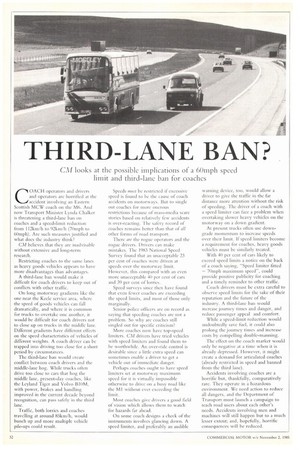THIRD-LANE BAN?
Page 34

If you've noticed an error in this article please click here to report it so we can fix it.
CM looks at the possible implications of a 60mph speed limit and third-lane ban for coaches
COACH operators and drivers and operators are horrified at the accident involving an Eastern Scottish MCW coach on the M6. And now Transport Minister Lynda Chalker is threatening a third-lane ban on coaches and a speed-limit reduction from 112km/h to 92km/h (70mph to 60mph). Are such measures justified and what does the industry think?
CM believes that they are inadvisable without extensive and long-term research.
Restricting coaches to the same lanes as heavy goods vehicles appears to have more disadvantages than advantages.
A third-lane ban would make it difficult for coach drivers to keep out of conflicts with other traffic.
On long motorway gradients like the one near the Keck service area, where the speed of goods vehicles can fall dramatically, and where it is common for trucks to overtake one another, it would be difficult for coach drivers not to close up on trucks in the middle lane. Different gradients have different effects on the speed characteristics of vehicles of different weights. A coach driver can be trapped into driving too close for a short period by circumstances.
The third-lane ban would create conflict between coach drivers and the middle-lane hog. While trucks often drive COO dose to cars that hog the middle lane, present-day coaches, like the Leyland Tiger and Volvo MOM, with power, brakes and handling improved in the current decade beyond recognition, can pass safely in the third lane.
Traffic, both lorries and coaches travelling at around 85km/b, would bunch up and more multiple vehicle pile-ups could result.
Speeds must he restricted if excessive speed is found to be the cause of coach accidents on motorways. But to single out coaches for more onerous restrictions because of mass-media scare stories based on relatively few accidents is over-reacting. The safety record of coaches remains better than that of all other forms of road transport.
There are the rogue operators and the rogue drivers. Drivers can make mistakes. The 1983 National Speed Survey found that an unacceptable 23 per cent of coaches were driven at speeds over the motorway limit. However, this compared with an even more unacceptable 40 per cent of cars and 39 per cent of lorries.
Speed surveys since then have found that even fewer coaches are exceeding the speed limits, and most of those only marginally.
Senior police officers are on record as saying that speeding coaches are not a problem. So why are coaches still singled out for specific criticism?
More coaches now have top-speed limiters. CM drivers have tried vehicles with speed limiters and found them to hv worthwhile. An over-ride control is desirable since a little extra speed can sometimes enable a driver to get a vehicle out of immediate danger.
Perhaps coaches ought to have speed Ii miters set at in maximum speed for it is virtually impossible otherwise to drive on a busy road like the Ml without ever exceeding the limit.
Most coaches give drivers a good field of vision winch allows them to watch for hazards far ahead.
On sonic coach designs a check of the instruments involves glancing down. A speed limiter, and preferably an audible warning device, too, would allow a driver to give the traffic in the far distance more attention without the risk of speeding. The driver of a coach with a speed limiter can face a problem when overtaking slower heavy vehicles on the motorway on a down gradient.
At present trucks often use downgrade momentum to increase speeds over their limit. If speed limiters become a requirement for coaches, heavy goods vehicles must be similarly treated.
With 40 per cent of cars likely to exceed speed limits a notice on the back of a coach saying, "Speed limiter fitted — 70mph MAXIMUM speed-, could provide positive publicity for coaching and a timely reminder to other traffic.
Coach drivers must be extra careful to observe speed limits for the sake of their reputation and the future of the industry. A third-lane ban would increase journey nines and danger, and reduce passenger appeal and comfort, While a speed-limit reduction would undoubtedly save Mel, it could also prolong the journey times and increase costs by compelling double-marming.
The effect on the coach market would only be negative at a time when it is already depressed. However, it might create a demand for articulated coaches (already restricted in speed and banned from the third lane).
Accidents involving coaches are a horrific but, thankfully, comparatively rare. They operate in a hazardous environment. We need action to reduce all dangers, and the Department of Transport must launch a campaign to teach road users about each other's needs. Accidents involving men and machines will still happen but to a much lesser extent; and, hopefully, horrific consequences will be reduced.












































































































